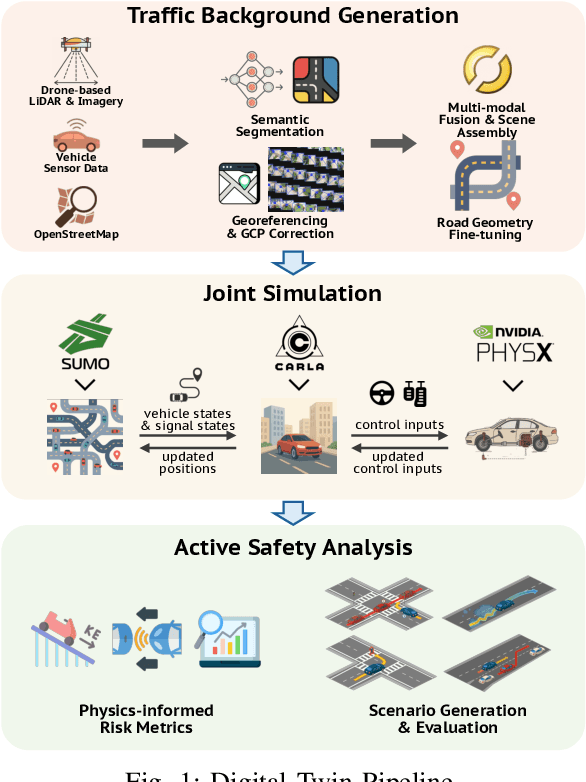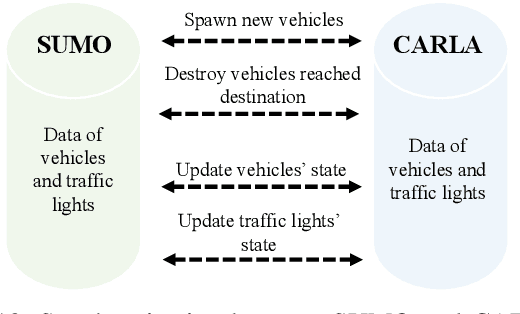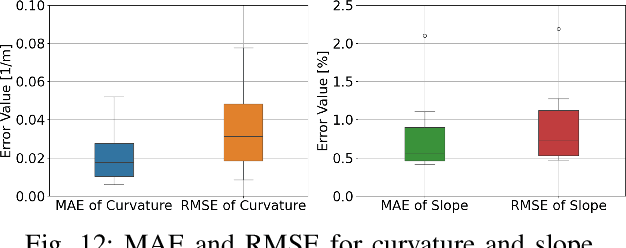autonomous cars
Autonomous cars are self-driving vehicles that use artificial intelligence (AI) and sensors to navigate and operate without human intervention, using high-resolution cameras and lidars that detect what happens in the car's immediate surroundings. They have the potential to revolutionize transportation by improving safety, efficiency, and accessibility.
Papers and Code
Highly Accurate and Diverse Traffic Data: The DeepScenario Open 3D Dataset
Apr 24, 2025Accurate 3D trajectory data is crucial for advancing autonomous driving. Yet, traditional datasets are usually captured by fixed sensors mounted on a car and are susceptible to occlusion. Additionally, such an approach can precisely reconstruct the dynamic environment in the close vicinity of the measurement vehicle only, while neglecting objects that are further away. In this paper, we introduce the DeepScenario Open 3D Dataset (DSC3D), a high-quality, occlusion-free dataset of 6 degrees of freedom bounding box trajectories acquired through a novel monocular camera drone tracking pipeline. Our dataset includes more than 175,000 trajectories of 14 types of traffic participants and significantly exceeds existing datasets in terms of diversity and scale, containing many unprecedented scenarios such as complex vehicle-pedestrian interaction on highly populated urban streets and comprehensive parking maneuvers from entry to exit. DSC3D dataset was captured in five various locations in Europe and the United States and include: a parking lot, a crowded inner-city, a steep urban intersection, a federal highway, and a suburban intersection. Our 3D trajectory dataset aims to enhance autonomous driving systems by providing detailed environmental 3D representations, which could lead to improved obstacle interactions and safety. We demonstrate its utility across multiple applications including motion prediction, motion planning, scenario mining, and generative reactive traffic agents. Our interactive online visualization platform and the complete dataset are publicly available at app.deepscenario.com, facilitating research in motion prediction, behavior modeling, and safety validation.
A Knowledge-Informed Deep Learning Paradigm for Generalizable and Stability-Optimized Car-Following Models
Apr 19, 2025Car-following models (CFMs) are fundamental to traffic flow analysis and autonomous driving. Although calibrated physics-based and trained data-driven CFMs can replicate human driving behavior, their reliance on specific datasets limits generalization across diverse scenarios and reduces reliability in real-world deployment. Moreover, these models typically focus on behavioral fidelity and do not support the explicit optimization of local and string stability, which are increasingly important for the safe and efficient operation of autonomous vehicles (AVs). To address these limitations, we propose a Knowledge-Informed Deep Learning (KIDL) paradigm that distills the generalization capabilities of pre-trained Large Language Models (LLMs) into a lightweight and stability-aware neural architecture. LLMs are used to extract fundamental car-following knowledge beyond dataset-specific patterns, and this knowledge is transferred to a reliable, tractable, and computationally efficient model through knowledge distillation. KIDL also incorporates stability constraints directly into its training objective, ensuring that the resulting model not only emulates human-like behavior but also satisfies the local and string stability requirements essential for real-world AV deployment. We evaluate KIDL on the real-world NGSIM and HighD datasets, comparing its performance with representative physics-based, data-driven, and hybrid CFMs. Both empirical and theoretical results consistently demonstrate KIDL's superior behavioral generalization and traffic flow stability, offering a robust and scalable solution for next-generation traffic systems.
An Optimized Density-Based Lane Keeping System for A Cost-Efficient Autonomous Vehicle Platform: AurigaBot V1
Apr 05, 2025



The development of self-driving cars has garnered significant attention from researchers, universities, and industries worldwide. Autonomous vehicles integrate numerous subsystems, including lane tracking, object detection, and vehicle control, which require thorough testing and validation. Scaled-down vehicles offer a cost-effective and accessible platform for experimentation, providing researchers with opportunities to optimize algorithms under constraints of limited computational power. This paper presents a four-wheeled autonomous vehicle platform designed to facilitate research and prototyping in autonomous driving. Key contributions include (1) a novel density-based clustering approach utilizing histogram statistics for landmark tracking, (2) a lateral controller, and (3) the integration of these innovations into a cohesive platform. Additionally, the paper explores object detection through systematic dataset augmentation and introduces an autonomous parking procedure. The results demonstrate the platform's effectiveness in achieving reliable lane tracking under varying lighting conditions, smooth trajectory following, and consistent object detection performance. Though developed for small-scale vehicles, these modular solutions are adaptable for full-scale autonomous systems, offering a versatile and cost-efficient framework for advancing research and industry applications.
Clip4Retrofit: Enabling Real-Time Image Labeling on Edge Devices via Cross-Architecture CLIP Distillation
May 23, 2025Foundation models like CLIP (Contrastive Language-Image Pretraining) have revolutionized vision-language tasks by enabling zero-shot and few-shot learning through cross-modal alignment. However, their computational complexity and large memory footprint make them unsuitable for deployment on resource-constrained edge devices, such as in-car cameras used for image collection and real-time processing. To address this challenge, we propose Clip4Retrofit, an efficient model distillation framework that enables real-time image labeling on edge devices. The framework is deployed on the Retrofit camera, a cost-effective edge device retrofitted into thousands of vehicles, despite strict limitations on compute performance and memory. Our approach distills the knowledge of the CLIP model into a lightweight student model, combining EfficientNet-B3 with multi-layer perceptron (MLP) projection heads to preserve cross-modal alignment while significantly reducing computational requirements. We demonstrate that our distilled model achieves a balance between efficiency and performance, making it ideal for deployment in real-world scenarios. Experimental results show that Clip4Retrofit can perform real-time image labeling and object identification on edge devices with limited resources, offering a practical solution for applications such as autonomous driving and retrofitting existing systems. This work bridges the gap between state-of-the-art vision-language models and their deployment in resource-constrained environments, paving the way for broader adoption of foundation models in edge computing.
A Champion-level Vision-based Reinforcement Learning Agent for Competitive Racing in Gran Turismo 7
Apr 12, 2025Deep reinforcement learning has achieved superhuman racing performance in high-fidelity simulators like Gran Turismo 7 (GT7). It typically utilizes global features that require instrumentation external to a car, such as precise localization of agents and opponents, limiting real-world applicability. To address this limitation, we introduce a vision-based autonomous racing agent that relies solely on ego-centric camera views and onboard sensor data, eliminating the need for precise localization during inference. This agent employs an asymmetric actor-critic framework: the actor uses a recurrent neural network with the sensor data local to the car to retain track layouts and opponent positions, while the critic accesses the global features during training. Evaluated in GT7, our agent consistently outperforms GT7's built-drivers. To our knowledge, this work presents the first vision-based autonomous racing agent to demonstrate champion-level performance in competitive racing scenarios.
Deployable and Generalizable Motion Prediction: Taxonomy, Open Challenges and Future Directions
May 14, 2025Motion prediction, the anticipation of future agent states or scene evolution, is rooted in human cognition, bridging perception and decision-making. It enables intelligent systems, such as robots and self-driving cars, to act safely in dynamic, human-involved environments, and informs broader time-series reasoning challenges. With advances in methods, representations, and datasets, the field has seen rapid progress, reflected in quickly evolving benchmark results. Yet, when state-of-the-art methods are deployed in the real world, they often struggle to generalize to open-world conditions and fall short of deployment standards. This reveals a gap between research benchmarks, which are often idealized or ill-posed, and real-world complexity. To address this gap, this survey revisits the generalization and deployability of motion prediction models, with an emphasis on the applications of robotics, autonomous driving, and human motion. We first offer a comprehensive taxonomy of motion prediction methods, covering representations, modeling strategies, application domains, and evaluation protocols. We then study two key challenges: (1) how to push motion prediction models to be deployable to realistic deployment standards, where motion prediction does not act in a vacuum, but functions as one module of closed-loop autonomy stacks - it takes input from the localization and perception, and informs downstream planning and control. 2) how to generalize motion prediction models from limited seen scenarios/datasets to the open-world settings. Throughout the paper, we highlight critical open challenges to guide future work, aiming to recalibrate the community's efforts, fostering progress that is not only measurable but also meaningful for real-world applications.
Virtual Roads, Smarter Safety: A Digital Twin Framework for Mixed Autonomous Traffic Safety Analysis
Apr 24, 2025



This paper presents a digital-twin platform for active safety analysis in mixed traffic environments. The platform is built using a multi-modal data-enabled traffic environment constructed from drone-based aerial LiDAR, OpenStreetMap, and vehicle sensor data (e.g., GPS and inclinometer readings). High-resolution 3D road geometries are generated through AI-powered semantic segmentation and georeferencing of aerial LiDAR data. To simulate real-world driving scenarios, the platform integrates the CAR Learning to Act (CARLA) simulator, Simulation of Urban MObility (SUMO) traffic model, and NVIDIA PhysX vehicle dynamics engine. CARLA provides detailed micro-level sensor and perception data, while SUMO manages macro-level traffic flow. NVIDIA PhysX enables accurate modeling of vehicle behaviors under diverse conditions, accounting for mass distribution, tire friction, and center of mass. This integrated system supports high-fidelity simulations that capture the complex interactions between autonomous and conventional vehicles. Experimental results demonstrate the platform's ability to reproduce realistic vehicle dynamics and traffic scenarios, enhancing the analysis of active safety measures. Overall, the proposed framework advances traffic safety research by enabling in-depth, physics-informed evaluation of vehicle behavior in dynamic and heterogeneous traffic environments.
SEB-Naver: A SE(2)-based Local Navigation Framework for Car-like Robots on Uneven Terrain
Mar 05, 2025Autonomous navigation of car-like robots on uneven terrain poses unique challenges compared to flat terrain, particularly in traversability assessment and terrain-associated kinematic modelling for motion planning. This paper introduces SEB-Naver, a novel SE(2)-based local navigation framework designed to overcome these challenges. First, we propose an efficient traversability assessment method for SE(2) grids, leveraging GPU parallel computing to enable real-time updates and maintenance of local maps. Second, inspired by differential flatness, we present an optimization-based trajectory planning method that integrates terrain-associated kinematic models, significantly improving both planning efficiency and trajectory quality. Finally, we unify these components into SEB-Naver, achieving real-time terrain assessment and trajectory optimization. Extensive simulations and real-world experiments demonstrate the effectiveness and efficiency of our approach. The code is at https://github.com/ZJU-FAST-Lab/seb_naver.
Representation Improvement in Latent Space for Search-Based Testing of Autonomous Robotic Systems
Mar 26, 2025



Testing autonomous robotic systems, such as self-driving cars and unmanned aerial vehicles, is challenging due to their interaction with highly unpredictable environments. A common practice is to first conduct simulation-based testing, which, despite reducing real-world risks, remains time-consuming and resource-intensive due to the vast space of possible test scenarios. A number of search-based approaches were proposed to generate test scenarios more efficiently. A key aspect of any search-based test generation approach is the choice of representation used during the search process. However, existing methods for improving test scenario representation remain limited. We propose RILaST (Representation Improvement in Latent Space for Search-Based Testing) approach, which enhances test representation by mapping it to the latent space of a variational autoencoder. We evaluate RILaST on two use cases, including autonomous drone and autonomous lane-keeping assist system. The obtained results show that RILaST allows finding between 3 to 4.6 times more failures than baseline approaches, achieving a high level of test diversity.
Car-1000: A New Large Scale Fine-Grained Visual Categorization Dataset
Mar 16, 2025



Fine-grained visual categorization (FGVC) is a challenging but significant task in computer vision, which aims to recognize different sub-categories of birds, cars, airplanes, etc. Among them, recognizing models of different cars has significant application value in autonomous driving, traffic surveillance and scene understanding, which has received considerable attention in the past few years. However, Stanford-Car, the most widely used fine-grained dataset for car recognition, only has 196 different categories and only includes vehicle models produced earlier than 2013. Due to the rapid advancements in the automotive industry during recent years, the appearances of various car models have become increasingly intricate and sophisticated. Consequently, the previous Stanford-Car dataset fails to capture this evolving landscape and cannot satisfy the requirements of automotive industry. To address these challenges, in our paper, we introduce Car-1000, a large-scale dataset designed specifically for fine-grained visual categorization of diverse car models. Car-1000 encompasses vehicles from 165 different automakers, spanning a wide range of 1000 distinct car models. Additionally, we have reproduced several state-of-the-art FGVC methods on the Car-1000 dataset, establishing a new benchmark for research in this field. We hope that our work will offer a fresh perspective for future FGVC researchers. Our dataset is available at https://github.com/toggle1995/Car-1000.
 Add to Chrome
Add to Chrome Add to Firefox
Add to Firefox Add to Edge
Add to Edge